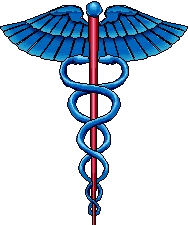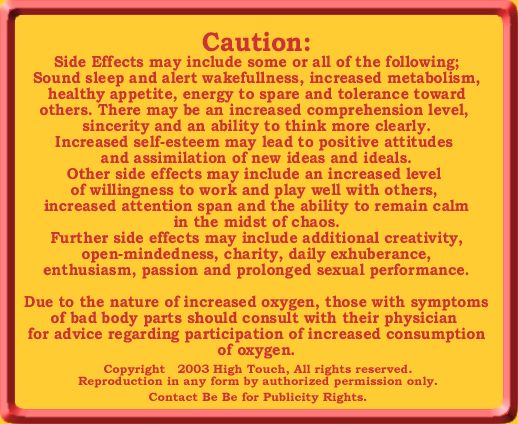

Hyperbaric Breathing is a breathing technique invented by Be
Be in the early 1980's. During research into extracurricular activities in
the environment of a floatation tank, also known as a sensory deprivation
tank, Be Be observed the unique ability of a floater to retune mental sensors
of the mind to detect stimuli that goes by unnoticed. She began to investigate
ways to sharpen the clarity of that perception by increasing the oxygen content
of her body, namely the circulatory system and the brain.
This approach to increased quantities of Oxygen occurs by performing
a breathing technique Be Be calls HyperBaric Breathing. In her fresh air breathing
clinics she teaches the skill of HyperBaric Breathing. By performing a specific
manner of breathing and pairing it up with a simple 16 beat rhythm... participating
breathers experience a heightened sense of awareness, an extraordinary ability
to focus and so much more.
The reason Be Be grandstands Hyperbaric Breathing comes from
years of observation. Looking around at John and Jane Q. Public and seeing
that no-one was breathing correctly. It's like there's a missing link or a
missing trigger device that results in breathing wrong; i.e., incorrectly.
The Trigger Device!
There is a trigger device goes off in our brain that signals the body to
take a breath, to expel the carbon dioxide buildup from the lungs. Carbon
dioxide is a gas that results from spent oxygen. Plants thrive on carbon dioxide
and turn it back into oxygen.
A myriad of problems develop in those who, through no fault of their own,
maintain a poor oxygen content in their body. Shallow breathers, those crippled
by fear and smokers experience behavioral problems resulting from oxygen deprivation
to the brain for thinking clearly.
Smokers interpret the signal from this trigger device as a need for another
cigarette. Shallow air breathers are overcome by the trigger devices' signal
and take a very quick breath trough the mouth to simply relieve the lungs
from too much carbon dioxide. And those who allow themselves to become paralyzed
by fear simply pass out and go brain dead! Most people who live in fear breathe
very infrequently and when they do, they invariably breathe through their
mouths.
Long established as the primary therapy in the treatment of
medical disorders, such as carbon monoxide poisoning and gas gangrene, hyperbaric
oxygen therapy is now increasingly being used on an adjunctive basis in the
management of a variety of disorders refractory to standard medical and surgical
care. HBO (HyperBaric Oxygen) has been shown to be particularly
effective in treating problem wounds, chronic bone infections and radiation
injury.
In traditional HBO therapy, the patient is placed in a specially
designed chamber (Photos)
costing hundreds of thousands of dollars. The pressure in the chamber is increased,
and 100% oxygen is breathed. Alveolar oxygen pressure is increased, causing
a rise in plasma oxygen content which results in enhanced tissue oxygen delivery.
The amount of pressure increase and the length of time under pressure being
determined by the condition being treated. Treatment pressures are typically
between 2 and 3 times local atmospheric pressure.


Treatments
in a hyperbaric oxygen chamber usually last from 1 to 2 hours.
Effects
of HyperBaric Oxygen therapy
1.
Mechanical effect of increased pressure
Any
free gas trapped in a body will decrease in volume
as pressure exerted on it increases (Boyle's Law).
Reduction in bubble size may allow it to pass through the circulation,
or at least travel into a smaller vessel which will reduce the size of any
resulting infarction.
This effect is useful in the management of gas embolism and decompression
sickness.
2.
Mass Action of gases
Flooding
the body with oxygen forces the rapid elimination of other gases,
thus reducing damage caused by toxic gases such as carbon monoxide.
This is what we breath all day while driving or riding in traffic.
The elevated pressures used during hyperbaric oxygen therapy
further accelerates the elimination process.
3.
Vasoconstriction
Hyperbaric
oxygen acts as an alpha-adrenergic drug.
Vasoconstriction can result in reduction of edema following burns or crush
injuries.
Even with a reduction in blood flow, enough extra oxygen is carried by the
blood
so a net increase in tissue oxygen delivery occurs with hyperbaric oxygen.
4.
Antibacterial effect
Anaerobic
bacteria don't contain the natural defenses
to protect them from the superoxides, peroxides
and other compounds formed in the presence of high oxygen tensions.
More importantly, many of the body's bacterial defense mechanisms are oxygen
dependent.
When tissue HO2 drops too low, effective ingestion and killing by phagocytic
leukocytes is retarded.
Reoxygenation of those tissues allows phagocytosis
and other host defense mechanisms to come back into play.
5.
Anti-ischemic effect
Hyperbaric
oxygen physically dissolves extra oxygen into the plasma (Henry's Law).
The quantity of oxygen carried and transferred to ischemic tissue by the blood
is increased.
Relieving the ischemia with this increased oxygenation
promotes osteoclastic and osteoblastic activity,
collagen matrix formation and the breakdown of many toxins.
The extra oxygen also helps the ischemic tissue
meet the increased metabolic need required by healing processes.
--------------------------------------------------------------------------------
Indications
for HBO.
HBO is generally used as an adjunctive therapy.
HBO does not compete with or replace other treatment methods.
Accepted indications for hyperbaric oxygen therapy
encompass a wide range of clinical conditions including:
Air
or Gas Embolism
Carbon Monoxide Poisoning
Crush Injury,
Compartment Syndrome, and other Acute traumatic Ischemias
Cyanide Poisoning
Decompression Sickness
Enhancement of Healing in Selected Problem Wounds;
Acute Peripheral Arterial Insufficiency.
Dermal Gangrene.
Refractory Osteomyelitis
Thermal Burns Preparation For Skin Grafting in previously compromised tissue.
· Selected Refractory Infections
· Exceptional Blood Loss Anemia
· Gas Gangrene
· Necrotizing Soft Tissue Infections
· Radiation Necrosis: Osteoradionecrosis and Soft Tissue Radiation Necrosis.
Skin Graft and Skin Flap Compromise.
Refractory Diabetic Wounds
Also included are the following psychotic
disabilities including but not limited to:
Attention Deficit Disorder
Depression
Anxiety
Fear psychosis
Anger
Disappointment Disability
Psychic Trauma
Obsession
Mental breakdowns, etc.
Helps to cope with the following
psychological conditions:
jealousy
betrayal
peer pressure
office stress
& performance anxiety


